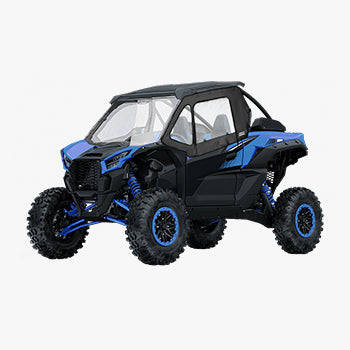Why Are Side by Sides so Expensive? 11 Factors!

If you’ve ever found yourself drooling over a shiny new side by side (SxS) at your local dealership or on an off-road trail, you’ve probably also done a double-take at the price tag. These all-terrain vehicles, perfect for everything from rugged trails to farm work, don’t come cheap, typically averaging around $20,000 in MSRP. But have you ever wondered why?
In this blog, we’ll break down the factors that make side by sides so pricey, figure out if they’re worth the investment, and share the prices of 10 popular SxS models released this year.
Let's jump right in!
11 Reasons Why Side by Sides Are So Expensive

1. Advanced Engineering and Design
Side-by-sides are pricey mainly because of their advanced engineering and design. These aren't just any ordinary vehicles; they're meticulously built to tackle tough terrains while keeping you comfortable and safe. They come with complex suspension systems, powerful engines, and strong frames, all designed for stability, power, and durability. All these features contribute significantly to the overall cost.
2. High-Quality Materials
Quality materials don't come cheap. Manufacturers use top-notch components to ensure longevity and performance. We're talking about heavy-duty steel frames, reinforced plastics, and high-grade aluminum parts. These materials can withstand extreme conditions, but they also add to the production costs.
*Heavy-Duty Steel and Aluminum: The frame and other critical components are often made from heavy-duty steel and high-grade aluminum. These materials provide the necessary strength and durability but come at a higher price.
*Reinforced Plastics: Parts like body panels, often use reinforced plastics that can take a beating without cracking or breaking. These specialized plastics are more costly than standard materials used in less demanding applications.
3. Safety Features
Safety is a big deal, especially when you’re speeding through rough terrains. Modern side by sides come equipped with safety features like roll cages, seat belts, and advanced braking systems. Some even have airbags! These features not only protect you but also meet stringent industry regulations, adding another layer to the cost.
4. Versatility and Multi-Purpose Use

One of the reasons side by sides are so popular is their versatility. They’re not just for recreational off-roading; they can be used for hunting, farming, and even snow plowing. This multi-purpose functionality often requires additional attachments and modifications, which can drive up the price. Essentially, you're paying for an all-in-one vehicle that can handle a wide range of tasks.
5. Tech Gadgets and Comfort
Today's side by sides are more than just rugged machines; they're also packed with technology and comfort features. From GPS systems and Bluetooth connectivity to heated seats and premium sound systems, these "extras" can quickly add up. While they might seem like luxuries, they enhance the overall experience, making those long rides much more enjoyable.
6. Brand Name and Reputation
Let's face it: brand names matter. Established brands like Polaris, Can-Am, and Yamaha have built reputations for reliability and performance. This brand value adds to the price tag, but it also provides peace of mind knowing you're investing in a trusted product. You're not just buying a machine; you're buying into years of engineering excellence and customer satisfaction.
7. Research and Development (R&D)
Creating a top-of-the-line side by side involves a lot of R&D. Companies invest millions in developing new technologies, testing prototypes, and ensuring quality control. These costs are eventually passed on to us. But this investment means we’re getting a vehicle that’s been meticulously designed and tested for optimal performance and safety.
8. Market Demand and Supply Chain Issues
Like any other product, the laws of supply and demand play a significant role in pricing. Side by sides have seen a surge in popularity, especially during the pandemic when outdoor activities became a safe way to have fun. This increased demand has led to higher prices. On top of that, supply chain problems and delays in getting parts and materials have made things worse, causing these vehicles to get even more expensive.
9. Customization Options

Many buyers want their side by sides customized to fit their specific needs. Whether it's adding a winch, specialized tires, or custom paint jobs, these modifications can significantly increase the price. Customization offers a personalized touch but comes at a premium. Even if you start with a basic model, aftermarket upgrades can be expensive. High-performance parts, enhanced lighting systems, and other add-ons can increase the final cost.
10. Maintenance and Longevity
The saying "you get what you pay for" holds true here. Spending more upfront often means lower maintenance costs in the long run. High-quality parts and meticulous engineering result in fewer breakdowns and repairs. Plus, a well-maintained side by side can last for years, making it a worthwhile investment.
11. Financing and Insurance Costs
Lastly, don't forget about the hidden costs like financing and insurance. High sticker prices mean higher monthly payments if you’re financing your purchase. Insurance premiums for side by sides can also be hefty, especially if you opt for comprehensive coverage. It's essential to factor these costs into your budget when considering a purchase.
Quick Look at Side-by-Side Prices
Here's a chart listing the top 10 popular side-by-sides for 2024 along with their Manufacturer's Suggested Retail Prices (MSRP).
|
Side-by-Side Model |
MSRP (USD) |
|
Polaris RZR Pro XP |
$24,599 |
|
Polaris Ranger XP 1000 Premium |
$19,999 |
|
Can-Am Maverick X3 DS Turbo RR |
$23,299 |
|
Can-Am Commander XT-P 1000R |
$22,199 |
|
Can-Am Defender Max Lone Star HD10 |
$20,799 |
|
Yamaha YXZ1000R SS XT-R |
$22,999 |
|
Honda Talon 1000X-4 Fox Live Valve |
$23,099 |
|
Honda Pioneer 1000-5 Deluxe |
$18,899 |
|
Kawasaki Teryx KRX 1000 |
$21,499 |
|
CF Moto ZForce 950 Sport |
$14,999 |
*These prices are estimates and can vary based on location, dealer, and optional features. And these MSRPs may be subject to change. Always confirm with local dealers for the most accurate pricing and available configurations.
Final Thoughts

So, here’s the thing! The cost of a side by side is influenced by a mix of advanced engineering, high-quality materials, safety features, and market dynamics, among other factors. While they may seem expensive, the value they offer in terms of versatility, performance, and longevity can make them worth every penny.
If you’re on the fence about buying one, consider what you’ll be using it for and how often. Sometimes, renting or opting for a used model might be a more budget-friendly option. Whatever you decide, make sure to do your homework and know exactly what you’re paying for.
And just so you know, even though side-by-sides can be expensive upfront, at Kemimoto we’ve got your back with hundreds of quality and stylish UTV aftermarket accessories that make your ride safer and more comfortable.









Leave a comment